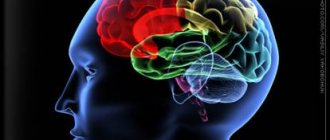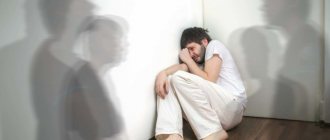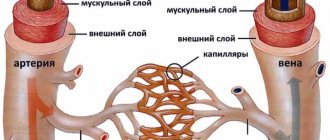Vestibulo-atactic syndrome is a disorder that occurs against the background of a disorder in the functioning of the body’s vascular system. The pathological process begins with subtle symptoms, which progress over time and lead to serious disorders of motor functions.
This pathology is a whole complex of motor and coordination disorders caused by impaired general blood circulation in the brain. This disorder is characterized by a sudden loss of balance, poor stability while walking and even standing, and falls.
This pathology is not an independent disease. Manifestations of the syndrome are the result of more severe illnesses. More often it occurs due to ischemia - a chronic circulatory disorder of the brain.
Sometimes dizziness and motor dysfunction can be manifestations not only of the pathology itself, but also of irreversible changes in the functions of the musculoskeletal and vestibular system that occur due to old age.
Stage by stage to disability
The disease is usually classified into stages, each of which is characterized by various coordination disorders:
- The mild stage
is a mild motor disorganization, which manifests itself in deterioration of coordination and disturbance of gait. - Moderate stage
- manifested by signs of disorder, gait becomes unsteady, headaches appear, accompanied by nausea. - Severe stage
- a person experiences significant difficulties when walking and standing, he becomes unable to move without assistance.
Causes and associated diseases
Vestibulo-ataxic syndrome is not a disease, but a condition that is provoked by pathologies already developed in a person. It accompanies people who have signs of a violation of the blood supply to the brain (they can be congenital or acquired), called ischemia. These conditions change the functions of the cerebellum and frontal part of the brain, which are responsible for the coordination of movements. Experts include the following to the list of pathologies:
- chronic vascular diseases, resulting in deterioration of blood flow in the vertebrobasilar region;
- atherosclerosis;
- arterial hypertension;
- development of tumor processes in the brain (they can be benign or malignant);
- multiple sclerosis;
- destruction of brain tissue, characteristic of ischemic or hemorrhagic stroke;
- dropsy of the brain in children (hydrocephalus);
- cerebral palsy;
- conditions after brain injuries and surgical interventions.
Vestibulo-atactic syndrome can be provoked by several factors. This may be due to unfavorable heredity, trauma (including birth). Aggressive external influences that a person receives throughout his life also contribute to the development of the condition:
- living in areas with hazardous environmental conditions;
- uncontrolled or long-term treatment with certain medications;
- regular excessive consumption of alcoholic beverages;
- smoking;
- radioactive exposure;
- damage by microorganisms that cause infectious diseases and their complications.
Vestibular ataxia can occur against the background of an imbalance or lack of certain microelements and vitamins in the human body.
Most often the reason is...
There are many reasons that cause this disorder, but the most common include:
- ischemia, which can be either congenital or acquired;
- disorders affecting the frontal-stem lobes of the brain;
- depletion of the cerebral cortex;
- dropsy of the brain (hydrocephalus);
- high blood pressure;
- atherosclerosis;
- head injuries;
- malignant neoplasms;
- osteochondrosis.
Treatment
It is recommended to take antihypertensive drugs, as well as drugs that help lower cholesterol. The person is given advice on changing his lifestyle and is prescribed a special diet. A prerequisite is to quit smoking.
To regulate the blood supply and functioning of the nervous system, as well as relieve symptoms, the use of antioxidants is indicated - Actovegin, Mildronate, Mexidol. Recommended drugs include Cavinton, Instenon and Trental.
For ischemia, symptomatic therapy includes antidepressants, usually of the benzodiazepine type. Among them, Grandaxin has the least number of side effects.
Neurologists who treat patients during rehabilitation procedures usually include physiotherapeutic procedures in their treatment.
In some cases, specialists resort to surgery for therapy. In this case, the operation is performed on the vertebral artery, at the intersection of the vasomotor fibers. This intervention helps to reduce spasms in the arteries and improve blood flow.
Physiatry requires daily monitoring of blood pressure and blood tests for cholesterol levels.
Clinical picture
Common symptoms of vestibuloatactic syndrome include:
- dizziness;
- flickering in the eyes;
- gait disturbance;
- headache;
- nausea;
- loss of balance;
- difficulty concentrating;
- feeling of being “thrown” in different directions;
- falls.
You can also identify secondary symptoms:
- sleep pattern disorder;
- feeling of noise and congestion in the ears;
- fast fatiguability;
- lethargy;
- low performance.
Prevention
Preventive measures are aimed at reducing the risk of ischemia. A prerequisite is giving up bad habits.
For prevention, it is necessary to avoid stress and reduce the duration of exposure to the sun. Physical activity should be moderate, but constant. One of the necessary preventive measures to prevent this pathology is the regulation of the patient’s body weight, because obesity directly affects the development of vestibular ataxia.
Establishing diagnosis
Before starting treatment, it is necessary to undergo a comprehensive diagnosis. In addition to a general examination and history taking, a neurological and otoneurological examination is prescribed, which makes it possible to determine disorders of the vestibular apparatus in a particular patient.
The following diagnostic procedures will also be prescribed:
- MRI
- determines circulatory disorders of the cerebral vascular system, as well as other central nervous system abnormalities; - Ultrasound
- examination of the cervical spine to detect osteochondrosis, in which narrowing of blood vessels occurs.
Diagnostics
The disease can be identified during a neurological examination and based on specific patient complaints. To clarify the diagnosis, a specialist may additionally prescribe instrumental studies:
- Rheoencephalography – helps assess blood circulation. If necessary, it is supplemented with magnetic resonance imaging or vascular angiography.
- Echoencephalography – assesses the state of the liquor system. When mixed, a formation (hematoma, tumor or abscess) can be suspected, which can provoke vestibular ataxia.
- Electroencephalography – helps analyze the bioelectrical activity of the brain.
- Computed tomography and magnetic resonance imaging can detect demyelinating processes in the brain and the presence of neoplasms.
- X-ray of the skull and spine is performed if the possibility of a craniovertebral anomaly is suspected.
Health care
Treatment of vestibulo atactic syndrome will be carried out in stages.
Conservative therapy
The main task at the first stage of treatment is antihypertensive therapy - a method aimed at reducing blood pressure, which is a fundamental factor leading to disorder of the vestibular system. Blood cholesterol levels are also reduced.
For this purpose, special drugs are prescribed to reduce cholesterol levels, such as statins, as well as a diet.
A healthy lifestyle will play a very important role in the treatment of pathology. The patient needs to give up bad habits and adhere to the correct daily routine.
Further therapy will depend on the established cause of the syndrome and the severity of its manifestations. To eliminate this pathology, it is necessary, first of all, to get rid of the main causes that led to this condition.
If the disorder occurs against the background of ischemic disease, drug therapy is prescribed using the following drugs:
- Mildronate
- improves oxygen cellular nutrition and metabolic processes; - Actovegin
is a stronger drug; - Mexidol
- has an antioxidant effect and also reduces cholesterol levels; - Trental, Cavinton, Instenon
- means for stimulating blood circulation in the brain; - antidepressants of the benzodiazepine group
- used in cases of more severe ischemia.
Favorable results can be achieved with complex treatment. In addition to taking a course of medications, the patient is prescribed physical therapy, which includes:
- special therapeutic exercises;
- acupuncture;
- acupressure head massage;
- herbal medicine.
An unconventional method such as hypnosis has proven itself quite well.
Surgery
Although in most cases traditional treatment gives very good results, sometimes it is impossible to do without surgical intervention. This applies, first of all, to patients with a severe stage of vestibulo-atactic syndrome, for whom all other methods of therapy have proven ineffective. In this case, a procedure is performed to intersect the vasomotor fibers of the vertebral artery.
This operation is carried out for the purpose of:
- reducing the risk of spasms in the blood vessels of the brain;
- improves blood circulation in the brain, resulting in the restoration of motor and coordination functions.
This method gained wide popularity about ten years ago. This operation is considered quite complex, and a positive result will directly depend on the level of training and qualifications of the specialist who performs it.
As practice shows, if the operation is successfully performed, a positive effect is observed in more than 70% of cases.
If treatment is started in a timely manner, the prognosis will be quite positive. Difficulties may arise due to irreversible age-related changes in the human body or serious illnesses, for example, tumors and cysts that require surgical intervention.
Complications of the pathology include a high risk of injury when the patient falls and spasms in the blood vessels of the brain.
Vestibulopathy or vestibular syndrome
Vestibulopathy is a widely known but difficult to define pathology, which is a set of symptoms that arise as a result of dysfunction of the vestibular apparatus.
It is characterized by frequent dizziness with a feeling of rotation of the surrounding space or one’s own body in space, the ground falling or running away from under one’s feet, unsteadiness of gait, difficulty maintaining balance, disorientation and confusion. May be accompanied by nausea and/or vomiting, diarrhea, anxiety, increased heart rate and urination, surges in blood pressure, sweating, redness or, conversely, pallor of the skin.
The vestibular apparatus is an organ located in the inner ear that perceives changes in the position of the body and head in space (static signals from balance receptors) and the direction of body movement (dynamic signals associated with acceleration). Some information is transmitted to the vestibular apparatus from visual analyzers. If, for example, a person’s visual field is suddenly turned upside down, and signals coming from the inner ear indicate an even position of the body, a conflict of perceptions will arise and complete or partial disorientation will result.
Signals generated by vestibular receptors are transmitted along nerve fibers to the cerebellum and nuclei of the brain stem, where they are processed. Then the impulses are sent to the motor part of the spinal cord, to the skeletal and ocular muscles to ensure that the body acquires an optimal stable posture corresponding to the current space. Any disease that causes a mismatch between incoming and outgoing nerve signals provokes dizziness.
Vestibular syndrome is a phenomenon that is of particular importance when collecting a clinical history of most psychovegetative diseases. It has been proven that with migraines, panic attacks, hyperventilation syndrome, and fainting, vestibulopathy is observed several times more often than with other diseases. In some cases, vegetative symptoms haunt patients since childhood, in others they arise much later, in parallel with the development of any pathology.
Causes of the disease
Quite often, vestibulopathy refers to poor tolerance to stimuli of the functional-dynamic apparatus of an idiopathic nature that has existed since childhood. It is interpreted as anomalies in the development of the vestibular system. Such children do not tolerate movement in any type of transport, swings, carousels, or going up in an elevator, but at the same time they can dance wonderfully without losing their balance. Over time, such patients develop a conditioned reflex, and dizziness begins even before boarding a vehicle and starting to move.
The causes of vestibular syndrome can be various diseases of the inner ear, brain, organs of vision, taking certain medications, as well as the natural processes of aging of the body. In these cases, the vestibulopathic symptomatic complex can manifest itself for a long time, almost chronically, or come in attacks, usually without disturbing the patient in any way between attacks.
The main and most common causes of vestibulopathy:
- Episodic benign positional paroxysmal dizziness when changing the position of the head in space, associated with pathologies of the inner ear. For example, a violation of lymph flow in one of the semicircular canals of the middle ear. Most often occurs in older people, in patients with metabolic disorders, after suffering neuritis or traumatic brain injury.
- Systemic dizziness and hearing impairment are characteristic of labyrinths (inflammation, otitis media of the inner ear) of various etiologies. Labyrinths can be bacterial (pathogens: streptococci, staphylococci, pneumococci, etc.) and viral (influenza, measles, rubella, tonsillitis, etc.).
- Labyrinthine infarction is the death of an organ due to insufficient blood supply. Elderly people suffering from vascular atherosclerosis or hypercoagulation are most often affected. Dizziness and instability of movements persist for several months until vestibular compensation occurs.
- Dizziness and vestibular disorders caused by traumatic damage to the thin bone membranes of the labyrinth, accompanied by hemorrhage in the middle ear or rupture of the eardrum, barotrauma (diving, straining, severe coughing).
- Meniere's disease is a classic example of acute systemic vertigo. The inner ear is affected. Attacks last from 1 to 24 hours, the frequency of attacks ranges from several times a day or 1-2 times a year. Accompanied by photosensitivity, sound fear, tinnitus, nausea, vomiting, floaters in the eyes, speech disorders, a feeling of pressure on the eardrums and unilateral hearing loss.
- Vestibular neuritis or neuronitis occurs due to viral infections (acute respiratory infections, influenza, herpes virus, etc.). Accompanied by sudden severe and prolonged dizziness (lasting up to several days) with attacks of nausea and vomiting, a feeling of anxiety and fear, imbalance and spontaneous nystagmus (involuntary blinking of the eyelids at a high frequency (up to several hundred times per minute)).
- A common cause of damage to the vestibular analyzers in elderly patients is vertebrobasilar insufficiency. Vascular factors are combined with lesions of the cerebellum and brain stems. The attacks last several minutes with complete loss of balance, spatial orientation, double vision, weakness and numbness of the limbs.
- Vestibulopathy can occur with the progression of pathological processes in the cervical spine. These may be osteochondrosis or osteoporosis diseases, vertebral instability, compression of nerve roots or vertebral arteries by formed protrusions or herniated intervertebral discs, etc.
In addition, frequent dizziness with accompanying symptoms accompany migraine attacks; thrombosis and hemorrhage in the circulatory system of the labyrinthine artery; poisoning caused by intoxication of the body with antibiotics or other drugs; some neurotic disorders; neuromas (tumors growing from nerve cells) of the cranial nerves; in case of occupational diseases (working in constant noise or vibration), etc.
Diagnosis and treatment of vestibular syndrome
Diagnosing vestibulopathy is quite difficult, since there are many causes of the disease and they cover an extensive list of factors. The search for the cause begins with collecting an anamnesis, conducting generally accepted studies (x-rays of the cervical spine, general blood test for hemoglobin and glucose levels, urinalysis, ECG). For a more detailed examination, CT or MRI diagnostics of the cervical spinal cord, brain, electrocochleography, duplex Dopplerography, pure-tone audiometry, etc. are performed.
Treatment of vestibular syndrome is prescribed only after a complete examination and establishment of a specific diagnosis. Treatment methods and medications used will depend on the troubling symptoms, the causes of the disease, and the individual characteristics of the body.
Among the general recommendations are:
- courses of exercise therapy, massages, physiotherapy, training on electric simulators;
- manual therapy sessions;
- limiting situations that can cause an attack of vestibulopathy;
- balanced, nutritious nutrition, if necessary, supplemented with vitamins and microelements;
- giving up bad habits, proper rest and sleep;
- taking antibiotics if vestibular disorders are caused by viral or infectious diseases of the inner or middle ear;
- taking medications that improve blood circulation in the brain (tanakan, ginkgo biloba, betaserc, etc.).
Surgical intervention is rarely required for vestibulopathy syndrome.
Usually these are cases of traumatic damage to the membranes of the labyrinth, hemorrhage or infarction of the labyrinth, which can be life-threatening for the patient. Author: K.M.N., Academician of the Russian Academy of Medical Sciences M.A. Bobyr
Classification and main features
Vestibulocerebellar syndrome can manifest itself in a patient to varying degrees. Doctors highlight the following:
- Easy. Its peculiarity is the absence of noticeable disorders in the patient. Those around you and the patient himself may notice minor changes in gait and poor coordination of movements performed.
- Moderate. The gait becomes special - the person staggers to the sides, the coordination of movements is significantly changed. The patient complains of stable headaches, feels dizzy (especially when moving), nausea, temporary darkening, flickering in the eyes, and twitching.
- Expressed. This degree of progression of the syndrome is characterized by the patient's ability to move independently. His gait is characterized by strong, chaotic movements of the body and limbs, which gives reason to others to perceive it as “drunk.” The patient is unable to give his body the desired position. It completely stops listening. The manifestations of additional disorders, which depend on the individual characteristics of the body, are increasing. A pronounced degree of vestibular ataxia presupposes the establishment of disability, since often a person completely loses the ability to work and care for himself independently.
Common symptoms indicating the possible development of vestibulo-atactic syndrome are the following types of coordination and motor disorders:
- inability to intentionally maintain stability of body position (posture) for a certain period of time;
- unsteady gait;
- change in coordination of movements;
- imbalance (both when walking and in a standing position), tendency to fall;
- the appearance of involuntary eye twitching.
Additional signs complement the clinical picture:
- tendency to increased fatigue, tiredness;
- increased headaches;
- frequent dizziness, which may be accompanied by darkening of the eyes, flickering in front of them, and tinnitus;
- it is difficult for a person to concentrate, he becomes distracted;
- thinking is disrupted, mental activity becomes difficult;
- There are difficulties with sleep: it can be short-term, signs of insomnia appear.
The disease can progress and take the form of discirculatory encephalopathy with vestibulo-atactic syndrome. With it, due to oxygen deficiency, irreversible processes occur in brain cells, as a result of which they die, provoking the development of encephalopathy. The process is accompanied by a decrease in intelligence, memory, and dementia.










